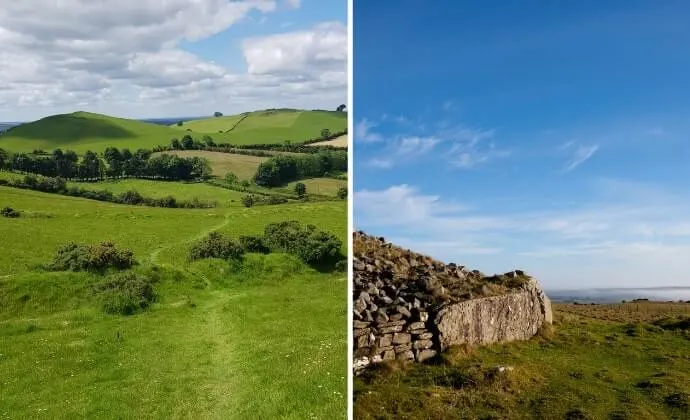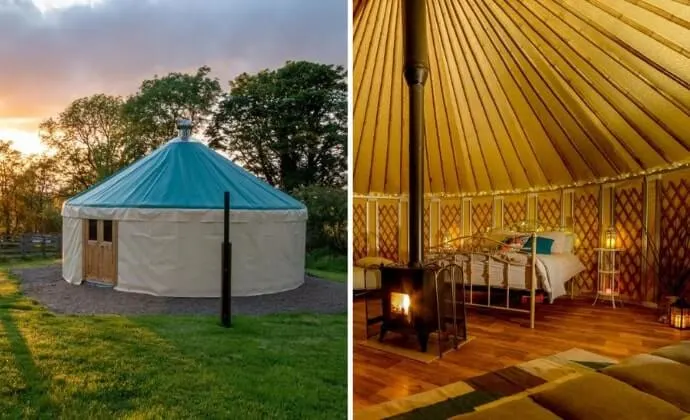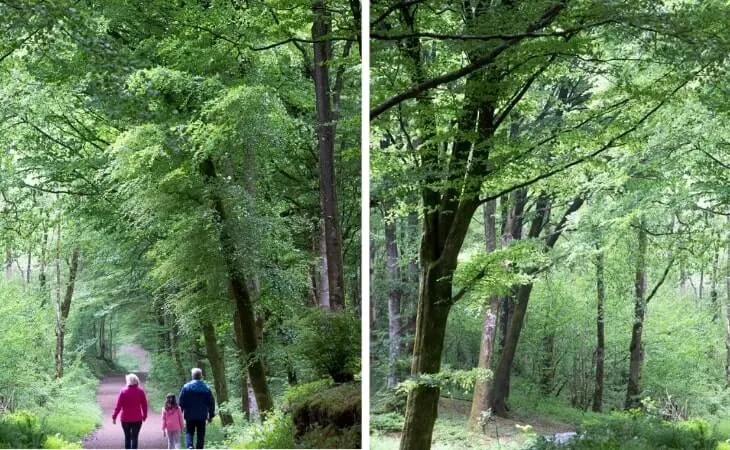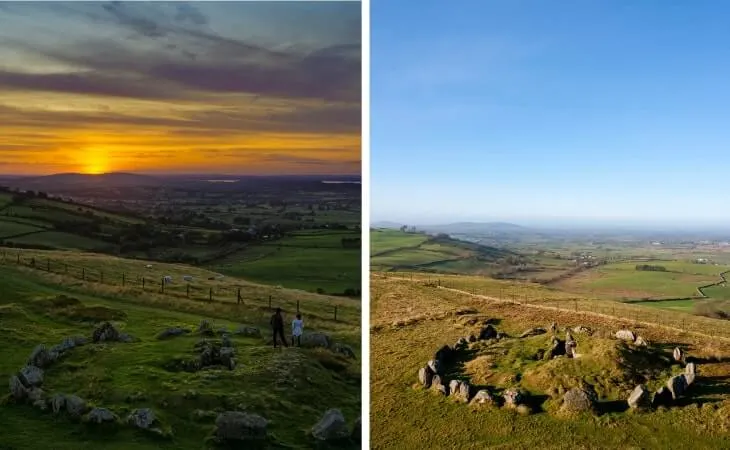A visit to Loughcrew Cairns is one of my favourite things to do in Meath.
And, although the climb to the top from the car park can be a struggle, it’s worth ever bit of sweat.
From the top of Loughcrew on a clear day, you’ll be treated to views of 18 (yes, 18!) different counties. Throw in its rich history and you can see why this place draws people from far and wide.
Below, you’ll find info one everything from parking and Loughcrew Gardens to the history of the area and more.
Some quick need-to-knows about Loughcrew

Photos via Shutterstock
Although a visit to Loughcrew Cairns is fairly straightforward, there are a few need-to-knows that’ll make your visit that bit more enjoyable.
1. Location
Loughcrew is situated in the northwest of County Meath, in Oldcastle. It’s a 20-minute drive from both Kells and Castlepollard, a 30-minute drive from Navan and a 75-minute drive from Dublin Airport.
2. Parking
You’ll find a small parking area (here on Google Maps) right at the start of the Loughcrew walk. There’s space for around 10 cars, once people park properly. The start of the trail is nice and visible from the car park.
3. A tough walk
If you want to reach the top of the hill at Loughcrew, make sure to bring a nice pair of comfortable shoes with you. The climb to the top is very steep, however, it’s relatively short and should take around 20 – 25 minutes.
4. Views galore
Climbing to the top of the hill may be challenging at times but the reward is worth it. The view from Loughcrew is breathtaking! On a clear day, it’s said that a whopping 18 counties are visible from its ‘summit’.
5. Never climb the cairn
Please, please, please avoid climbing the cairn. Despite extensive signage, people still climb this ancient structure and damage it little-by-little in the process.
The history of Loughcrew
It’s believed that the story of Loughcrew all began around 3,300 BC, which would make it older than nearby Newgrange (located at the Bru na Boinne complex).
The hills and the tombs at Loughcrew are known as Slieve na Calliagh, and they’re the highest point in County Meath.
Bronze and iron age
The remains of around 20 ancient tombs can be found at Loughcrew, each of which is said to offer evidence from different period of history (there’s also several Celtic symbols present).
A pin dating back to the Bronze Age was found in one of the cairns (‘Cairn T’) while bone dating to the Iron Age was found in another (Cairn H).
The discovery
The first one to mention Loughcrew Cairns in modern history was Louisa Beaufort, an Irish antiquarian, in 1828. Later, in 1863, a man from Trim named Eugene Conwell became infatuated with Loughcrew, after visiting with his wife.
He ended up being the first to excavate Loughcrew, and he found several bone pins, stone balls and beads in the process.
Further excavations and later years
Conwell’s initial excavation sparked interest and it was the driving force behind the follow up, which was done by Joseph Raftery – an archaeologist and director of the National Museum of Ireland.
Today only some of the cairns can be visited. In particular, Carnbane East, the main part of the complex, is owned by the Irish state, however, Carnbane West is situated upon private land, and can only be seen from afar.
Things to see and do at Loughcrew

Photo By Adam.Bialek (Shutterstock)
One of the reasons that a visit to Loughcrew Cairns is one of our favourite things to do in Meath is due to the sheer volume of things there are to see and do here. Here’s are some things to look out for.
1. The walk
The climb up Loughcrew is one of my favourite walks in Meath, and it’s a nice, short stroll that’s hard to beat while the sun is setting.
Throw on a pair of runners with good grip and start the trail from the car park, where you’ll need to conquer a flight of steps, first, before being greeted by some of the finest countryside in this corner of Ireland.
2. The cairn and tombs
The megalithic monuments at Loughcrew are spread across four different hills: Carrickbrack, Patrickstown Hill, Carnbane West and Carnbane East. Together with the hills they sit upon, these sites are known as Sliabh na Caillí.
This translates to ‘Mountain of the Cailleach’ (Cailleach was one of the more prominent Irish mythical creatures). According to legend, this site was formed when a giant hag dropped a large number of stones from her apron spreading them all over the surroundings.
More than twenty ancient tombs were found on this site. Many contain a cruciform chamber that has been covered by a mound while others are covered with Megalithic art.
Even though, according to Irish mythology, damaging these types of ancient tombs brings bad luck, parts of Loughcrew have been vandalised with graffiti. Please be respectful when you visit.
3. The view
The view from Loughcrew really is outstanding. Although its just over 900 feet in height, it’s the highest point in Meath, and the view packs a punch.
If you visit when the weather’s fine, you’ll have a panoramic view of patchwork-like green fields as far as the eye can see.
4. The equinoxes
In 1980, Martin Brennan, an American-Irish researcher, discovered that, during the spring and autumn equinoxes, the back stone in Cairn T was illuminated by the light of the rising sun.
Nowadays, during both occurrences, the OPW opens the entrance to the passage so that people can enter the chamber to see this amazing phenomenon.
The passage is quite narrow, so people only manage to enter in small groups of five or six.
Loughcrew gardens, glamping and megalithic centre

Photos via Booking.com
If, after seeing Loughcrew Cairns, you’re still itching for more, you’re in luck – there’s lots more to do in the area, from camping and glamping to coffee and more.
1. Loughcrew glamping and camping
You’ll find one of the more unique places to go glamping in Meath a stones throw from Loughcrew, in the megalithic centre. Here, you’ll find several cosy yurts which are available to rent. You can also go camping at Loughcrew, if you fancy, and the campsite here boasts mighty views to boot!
2. Loughcrew gardens
If you’re looking for family-friendly walks in Meath, head on over to Loughcrew Gardens for a nosey around. There’s fairy trails for the kids, the remains of a medieval motte and some ancient trees, too. There’s even an enchanted garden at certain times of the year.
3. Loughcrew Megalithic Centre
Loughcrew Megalithic Centre is a good starting point to explore the area from. Here, you can join one of three tours, if you’d like to be guided. Or, if you just fancy a pick-me-up, you can nip into the cafe.
Things to do near Loughcrew Cairns
One of the beauties of Loughcrew is that it’s a short spin away from many of the best things to do in Meath.
Below, you’ll find a handful of things to see and do a stone’s throw from Loughcrew Cairns (plus places to eat and where to grab a post-adventure pint!).
1. Fore Abbey (20-minute drive)

Photo by Eva Kmetty on Shutterstock
Fore Abbey is an ancient Benedictine Abbey that’s a short, 20-minute drive from Loughcrew Cairns. The abbey is situated in Collinstown, near Fore village, in County Westmeath. Fore Abbey was built in 630 and has housed 300 monks and 2,000 students!
2. Mullaghmeen Forest (15-minute drive)

Courtesy of Westmeath County Council
If you’re looking for a relaxing afternoon walk, get yourself to Mullaghmeen Forest. This beautiful area is situated 15-minutes from Loughcrew in Sheskernagh, County Westmeath. This is the largest planted beech forest in Ireland and here you will find many walking trails aimed at varying levels of fitness.
3. Tullynally Castle Gardens (20-minute drive)

Photos via Shutterstock
Tullynally Castle is situated in Castlepollard, County Westmeath and is a 20-minute drive from Loughcrew Cairns. This amazing castle is surrounded by twelve acres of extensive woodland gardens, walled gardens and even two ornamental lakes.
4. Deerpark Forest Walk (20-minute drive)
You’ll find the beautiful Deerpark Forest a 20-minute spin from Loughcrew. This national forest, situated on the east side of Lough Ramor, in County Cavan is perfect if you want to spend a day surrounded by nature. Here you will find endless acres of lush forest, several rivers and even some beaches!
FAQs about Loughcrew gardens, megalithic centre and cairns
We’ve had a lot of questions over the years asking about everything from ‘How old is loughcrew?’ (5,000 years+) to ‘Why was loughcrew built?’.
In the section below, we’ve popped in the most FAQs that we’ve received. If you have a question that we haven’t tackled, ask away in the comments section below.
Is Loughcrew really worth visiting?
Loughcrew Cairns will surprise you. Even if you have no interest in history, the views from the top of the hill are outstanding, and worth the he visit alone.
How many counties can you see from Loughcrew?
On a clear day, from the top of the hill at Loughcrew Cairns, you can see 18 counties.

